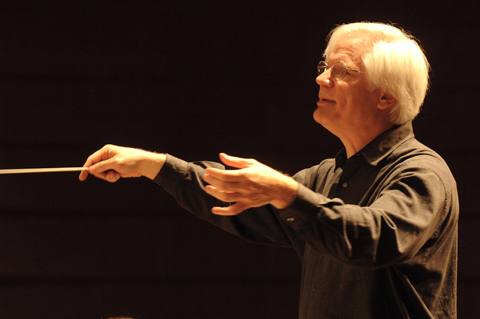
DAVID HOOSE led the Cantata Singers in a luminous performance of the Herbert Howells Requiem. |
Daniele Gatti’s Verdi Requiem with the BSO was a disappointment (though a friend tells me that the third performance was better than the one I heard). The same weekend (January 18), David Hoose, celebrating his 30th year directing the Cantata Singers, offered a Requiem at the First Congregational Church in Cambridge on a more modest scale than the Verdi, but it got to me on a deeper level. It was written by the British composer Herbert Howells around 1932, uncannily anticipating the sudden death of his nine-year-old son from polio. He kept it hidden, and it wasn’t performed until 1980, three years before Howells’s own death.
It’s a relatively quiet, relatively short piece: six slow, indrawn movements for (like everything in this concert) a cappella choir, mostly in English (the 23rd and 121st Psalms) alternating with Latin (Salvator mundi and Requiem aeternam), and ending with the hushed but more uplifting “I heard a voice from Heaven, saying unto me, Write” (Revelation 14:13).
Hoose placed the Howells at the center of a program of works focusing on the “Phrygian mode” — the scale of the piano’s white notes from E to E. Mary MacDonald, the Cantata Singers’ annotator, places this mode in the context of what she calls “archaic modernism,” its single semi-tone between the first two notes being nearly impossible to resolve, thus giving the music a sense of “timelessness, suspension . . . tension, ambiguity, and exotic otherness.” Howells’s dour suffering, and backward look to earlier centuries of English choral music, seems perfectly embodied in this Phrygian mode.
The Cantata Singers chorus has a wondrous glow these days that actually works in the odd, plummy acoustics of the First Church. The basses in particular have rarely sounded more sonorous. And the seven small solo parts were beautifully projected.
The evening began with more rarities: two motets by Anton Bruckner, Pange lingua (1843, revised 1868), from an Aquinas hymn, and the shorter but harmonically weirder Christus factus est (1884)), composed soon after the death of Wagner. Here too, everything breathed.
The concert ended with the strangest and liveliest piece, the Swiss composer Frank Martin’s Mass for Double Choir (1922; he added the Agnus Dei in 1926), another religious work so private it was not performed until many years later.
What surprises me in the Martin is not the Phrygian mode or the spiritual devoutness, but the coexistent sensuality of this music. The Kyrie and the overlapping voices in the Gloria and Hosanna were almost more seduction than prayer. Martin’s sense of awe is matched by his sense of celebration, and it was good to end with a piece that had such refreshingly dynamic changes in tempo.
------
Congratulations to oboist Peggy Pearson and soprano Kendra Colton for the successful completion of their third annual Bach Institute, in which professionals from Emmanuel Music mentor talented vocalists and instrumentalists from Oberlin and several Boston music schools. There are workshops, symposia, and a lot of rehearsals before the final public concert: a program of Bach cantata arias followed by a complete Bach cantata, with Emmanuel musicians in accompanying or — in the case of Peggy Pearson, our great Bach oboist — featured roles. Emmanuel Music artistic director Ryan Turner conducted the cantata, In allen meinen Taten (“In all my actions”), BWV 97, not among the most popular (or appealing) of the Bach cantatas, but here in a performance of compelling conviction and beauty.